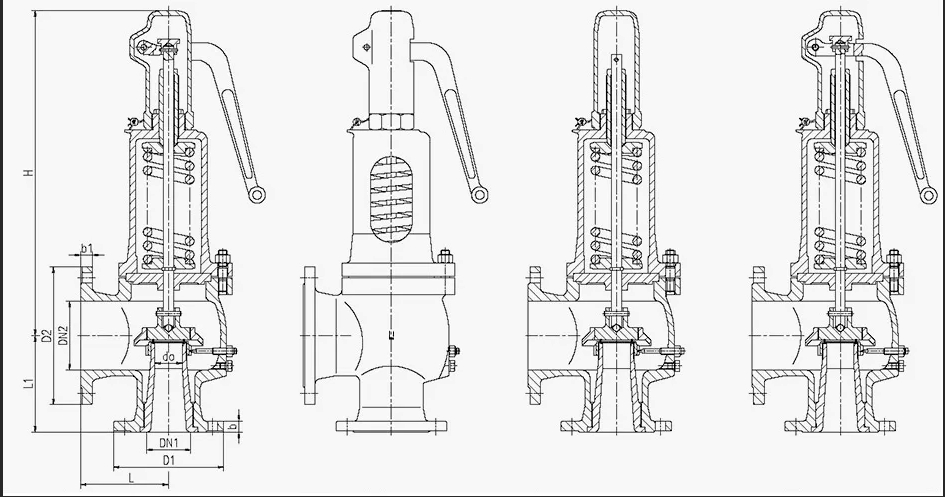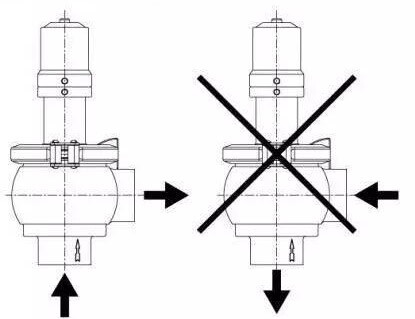
Operating in a normally closed position, safety valves are designed to release media to the atmosphere when the pressure within equipment or pipelines exceeds specified limits. This prevents the internal pressure of the system from surpassing predetermined values, thereby averting potential hazards.
As automatic valves, safety valves find widespread use in boilers, pressure vessels, and pipelines, where they play a crucial role in controlling pressure to ensure both personnel safety and equipment integrity. Before deployment, safety valves must undergo pressure testing to verify their functionality.
Safety valves are extensively employed in various applications, including steam boilers, liquefied petroleum gas (LPG) tankers, oil wells, bypass systems in steam power plants, pressure pipelines, and pressure vessels.
Safety valves typically feature smaller diameters, with common sizes ranging between DN15mm and DN80mm. Those exceeding 150mm are often referred to as large-diameter safety valves. They are further categorized into full lift and micro lift types, with variations in overall structure and loading methods, including static weight, lever, spring, and pilot-operated designs. Additionally, they are classified based on connection methods to pipelines as threaded or flanged safety valves.
Proper installation is integral to the functionality of safety valves. During initial operation, valve seats may suffer damage due to the presence of debris and impurities within the system. To prevent foreign matter from entering the valve, the entire system should undergo thorough flushing before valve installation. Safety valves should be installed in areas where dirt, rust, and debris do not accumulate.
In steam applications, reducing leakage tendencies through proper valve installation is crucial. Safety valves should be positioned to prevent condensate accumulation upstream of the valve disc. When installed correctly above steam pipelines, the inlet pipe of the safety valve can facilitate self-drainage.

Attention to detail during installation is essential:
1. New safety valves should come with product certificates, undergo recalibration before installation, be sealed with lead, and receive verification.
2. Safety valves should be vertically installed at the gas-liquid interface of containers or pipelines.
3. The outlet of safety valves should be unobstructed to prevent backpressure. If discharge pipes are installed, their inner diameter should exceed that of the safety valve outlet. Measures should be taken to prevent freezing at the discharge outlet.
4. No valves should be installed between pressure equipment and safety valves. For containers storing flammable, explosive, toxic, or viscous media, gate valves may be installed for easy replacement and cleaning, provided they do not hinder the normal operation of safety valves.
5. Pressure vessels containing flammable, explosive, or toxic media must have safety devices and recovery systems for discharged media. Lever safety valves must be installed vertically, while spring safety valves are best installed vertically to avoid interference with their operation. Attention should also be paid to the alignment and coaxiality of fittings and parts, ensuring even bolt loading.
The cross-sectional area of the short pipe connecting safety valves to boilers or pressure vessels must not be smaller than the flow area of the safety valve. All safety valves should be installed on a single pipe, with the cross-sectional area of the connecting pipe being at least 1.25 times the total flow area of the safety valves.
Installation Position and Requirements:
1. Install vertically upwards.
2. Install as close as possible to the equipment or pipeline being protected.
3. Install in easily accessible and adjustable locations with sufficient surrounding space.
4. For safety valves on pressure vessels, install in the gas-phase space above the liquid level of the vessel body or on pipelines where the connection point is in the gas-phase space of the pressure vessel.
5. For containers or equipment containing flammable, toxic, or viscous media, a globe valve may be installed before the safety valve, but the flow area of the globe valve must not be less than the minimum flow area of the safety valve. The globe valve must be sealed with lead to ensure it remains fully open at all times.
6. Safety valves should be installed in reverse to globe valves to reduce the influence of valve self-weight, avoid stress fatigue, and discharge vibration fatigue.
7. For safety valves susceptible to blockage or corrosion, install rupture discs before the inlet and check valves between the safety valve and rupture discs. Employ measures such as backflushing, heating, or insulation on the inlet pipeline to prevent blockage.
8. Safety valves installed on pipelines should be placed in locations where fluid pressure is relatively stable and at a distance from sources of fluctuation. They should not be installed in dead corners of horizontal pipelines.
9. For pipelines, heat exchangers, or pressure vessels containing liquid media where valve closure may cause pressure buildup due to thermal expansion, safety valves can be installed horizontally to discharge liquid directly downwards.
10. For emergency gas discharge, ensure the pipe end is flat, non-sharp, and free of burrs to prevent static discharge.
11. Installation points for safety valves should not subject them to excessive backpressure and should be within the allowable range.
12. The valve body of safety valves should be supported steadily.
13. For containers containing extremely hazardous, flammable, or explosive media, the discharge outlet of safety valves should lead to a safe location and be properly treated. When two or more safety valves share a discharge pipe, the cross-sectional area of the discharge pipe should not be less than the total sum of the cross-sectional areas of all safety valve outlets. However, oxygen or combustible gases, as well as two gases that can mutually react chemically, cannot share the same discharge pipe.
